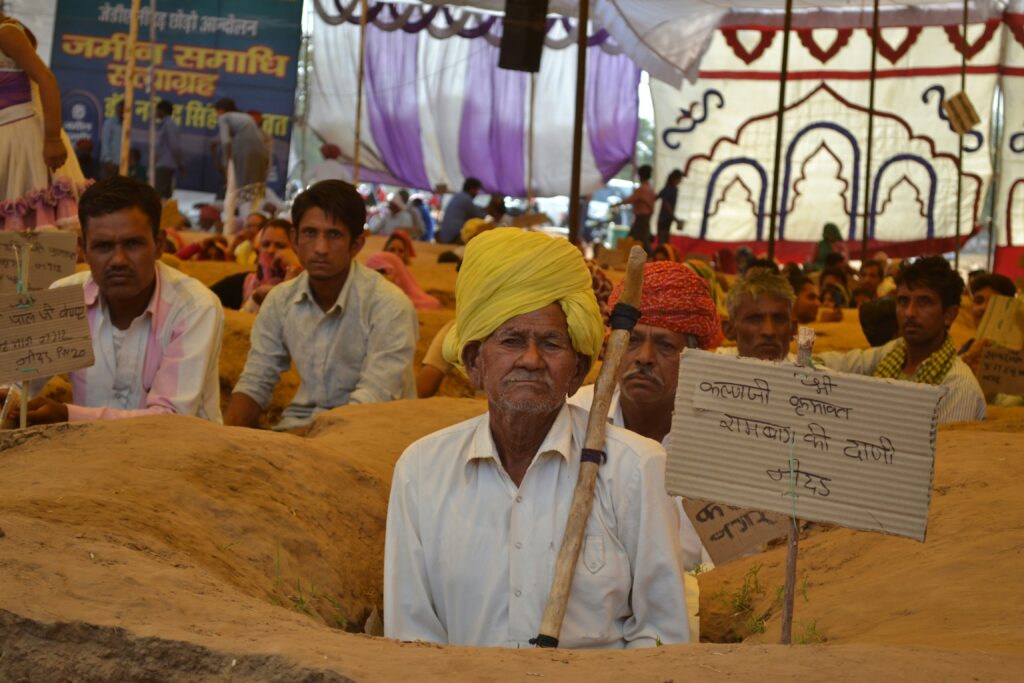India, a key emerging economy of the Global South, faces the harsh realities of climate change—droughts, floods, heatwaves, storms. Farmers, historically involved in several environmental movements, seem absent from the climate activism scene. For her master’s thesis, student researcher Pritha Mandal explores why.
It is the early 1970s…Indian farmers in the Garhwal region of the Himalayas embrace and stick to mighty Oak, Deodar, and Pine trees, protesting against state encroachment and felling of these broadleaf conifers…they mark the beginning of an inspirational environmental movement—one that will set the stage for Indian activism.
Soon, other environmental movements spring up—the Silent Valley Movement, the Narmada Bachao Andolan, and the Navdanya Movement—to name a few. These movements in the 70s and 80s witness large-scale public participation by local community leaders, students, social activists, environmentalists, human rights activists, academics, and primarily, the farming community.
Absent frontline communities
Fast-forward to the 21st century: India, a key emerging economy of the Global South, faces the harsh realities of climate change—droughts, floods, heatwaves, storms. One societal group is at the forefront of these impacts. They constitute the country’s largest employment sector, regularly witness changing temperature and rainfall patterns, and have serious repercussions on their livelihood: Indian farmers.
However, despite their historical involvement in several environmental movements in India, the farming community seems predominantly absent from the climate activism scene. Why are farmers in India, who are significantly vulnerable to climate change impacts, who have time and again fought for their land and livelihood, not involved in climate movements in India?
To understand the issue, I had a conversation with Shaik Imran, co-founder of Prakheti, an Indian non-governmental organization involved in agricultural sustainability and biodiversity conservation. Imran and his team work closely with farmers, helping them adopt sustainable agricultural practices and develop climate-resilient seed varieties.
What climate change means to Indian farmers
When asked about what the term “climate change” means to the farmers he works with, Imran emphasized how farmers are acutely aware of the impacts of climate change:
Imran: “Farmers are at the front line of this climate change issue, and they experience it on a daily level, through the means of rainfall, through heat stress, through flooding, through drought… When you explain it to them, or you talk to them about these issues, they would agree to each and every single one of them. In fact, they would end up giving you a lot more data of how things have changed on a microscopic and a macroscopic level as well. But they do not know that this is something known as climate change…”
Imran’s statements lead me to believe that although farmers in India have an elaborate understanding of the climate system and its change on a local level, their knowledge primarily comes from their experiences while working or supervising in their fields, rather than through education or scientific exposure.
Invisible movements?
The scientific framing of anthropogenic climate change, its socioeconomic impacts, its relevance to vulnerable groups such as the agricultural community, and the need for local and global action may not be immediately apparent to these farmers. Perhaps this explains the limited participation of farmers in Indian climate movements? This is what Imran had to say on the matter:
Imran: “I think farmers are engaged in climate movements a lot more than we perceive…I wouldn’t say they’re involved in global climate movements, most climate movements that farmers are participating in are very local…”
Imran’s words reflected the importance of visibility and framings of Indian climate movements. He emphasized how farmers’ involvement in climate activism is typically rooted in grassroot-level concerns—local land exploitation leading to environmental instability, corporate promotion of the use of non-sustainable products, and so on.
It’s the economy, again?
Although these grassroot-level movements often carry an “underlying tone of climate change,” they are not explicitly framed as climate movements. Instead, farmer participation in these implicitly environmental mobilizations largely reflects a broader desire for stable and secure livelihoods. Would that mean that farmers’ desire for consistent economic stability takes precedence over any other issue? Imran seemed to think so, with good reason:
Imran: “When it comes to [choosing between] economic stability and environmental concerns, the farmer would prioritize economic stability in most cases…”
According to Imran, it also does not help that existing climate movements in India do not necessarily identify and highlight persistent agricultural issues in their movements’ narratives. To make climate movements in India more relevant and appealing to farmers, Imran argues that farmers’ agricultural concerns and economic priorities—many of which stem from climate-related challenges—should be integrated into the movements’ narratives.
Alternative narratives
Does this then mean that there is an implicit disconnect between the priorities of the Indian farming sector and the narratives used by Indian climate movements? If such a disconnect does exist, are Indian climate movements aware of it? Would they be willing to adopt narratives that align better with this key societal group, or is the involvement of farmers not the most crucial for climate movements in India?
To begin unpacking these questions, we need to hear from Indian climate movements themselves. In my next post, we delve into my conversation with an active Indian climate activist. We talk about their climate movement’s narratives, communication strategies, societal reach, and analyze the possible disconnect we identified here…

